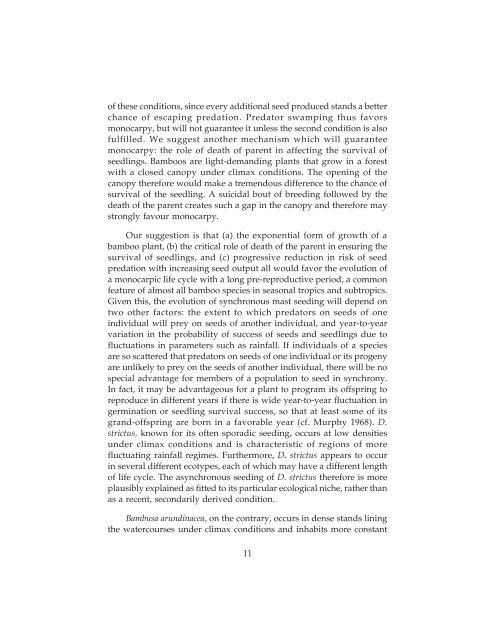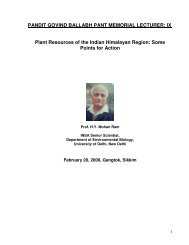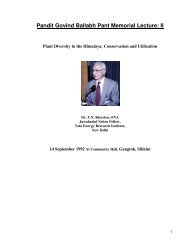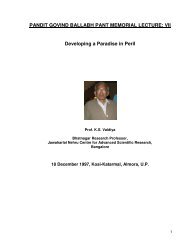Pt. Govind Ballabh Pant Memorial Lecture : XI
Pt. Govind Ballabh Pant Memorial Lecture : XI
Pt. Govind Ballabh Pant Memorial Lecture : XI
- No tags were found...
You also want an ePaper? Increase the reach of your titles
YUMPU automatically turns print PDFs into web optimized ePapers that Google loves.
of these conditions, since every additional seed produced stands a betterchance of escaping predation. Predator swamping thus favorsmonocarpy, but will not guarantee it unless the second condition is alsofulfilled. We suggest another mechanism which will guaranteemonocarpy: the role of death of parent in affecting the survival ofseedlings. Bamboos are light-demanding plants that grow in a forestwith a closed canopy under climax conditions. The opening of thecanopy therefore would make a tremendous difference to the chance ofsurvival of the seedling. A suicidal bout of breeding followed by thedeath of the parent creates such a gap in the canopy and therefore maystrongly favour monocarpy.Our suggestion is that (a) the exponential form of growth of abamboo plant, (b) the critical role of death of the parent in ensuring thesurvival of seedlings, and (c) progressive reduction in risk of seedpredation with increasing seed output all would favor the evolution ofa monocarpic life cycle with a long pre-reproductive period, a commonfeature of almost all bamboo species in seasonal tropics and subtropics.Given this, the evolution of synchronous mast seeding will depend ontwo other factors: the extent to which predators on seeds of oneindividual will prey on seeds of another individual, and year-to-yearvariation in the probability of success of seeds and seedlings due tofluctuations in parameters such as rainfall. If individuals of a speciesare so scattered that predators on seeds of one individual or its progenyare unlikely to prey on the seeds of another individual, there will be nospecial advantage for members of a population to seed in synchrony.In fact, it may be advantageous for a plant to program its offspring toreproduce in different years if there is wide year-to-year fluctuation ingermination or seedling survival success, so that at least some of itsgrand-offspring are born in a favorable year (cf. Murphy 1968). D.strictus, known for its often sporadic seeding, occurs at low densitiesunder climax conditions and is characteristic of regions of morefluctuating rainfall regimes. Furthermore, D. strictus appears to occurin several different ecotypes, each of which may have a different lengthof life cycle. The asynchronous seeding of D. strictus therefore is moreplausibly explained as fitted to its particular ecological niche, rather thanas a recent, secondarily derived condition.Bambusa arundinacea, on the contrary, occurs in dense stands liningthe watercourses under climax conditions and inhabits more constant11











